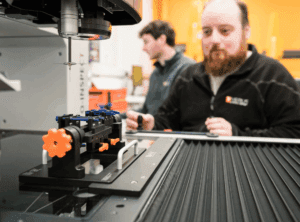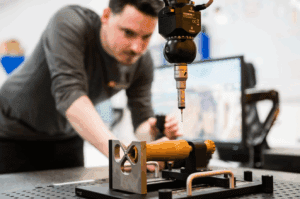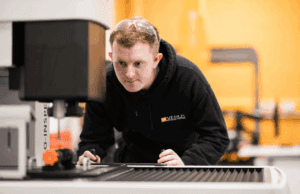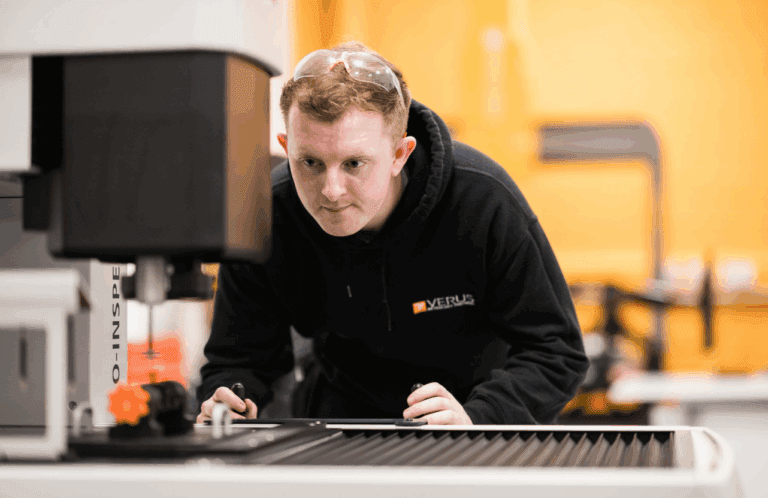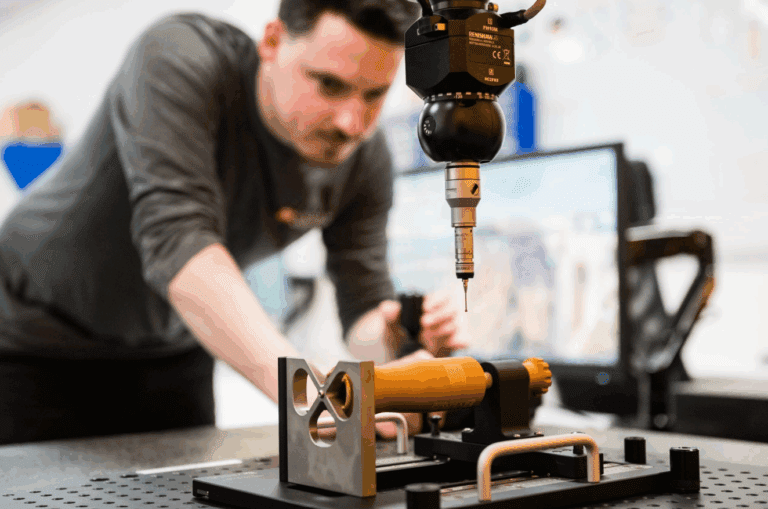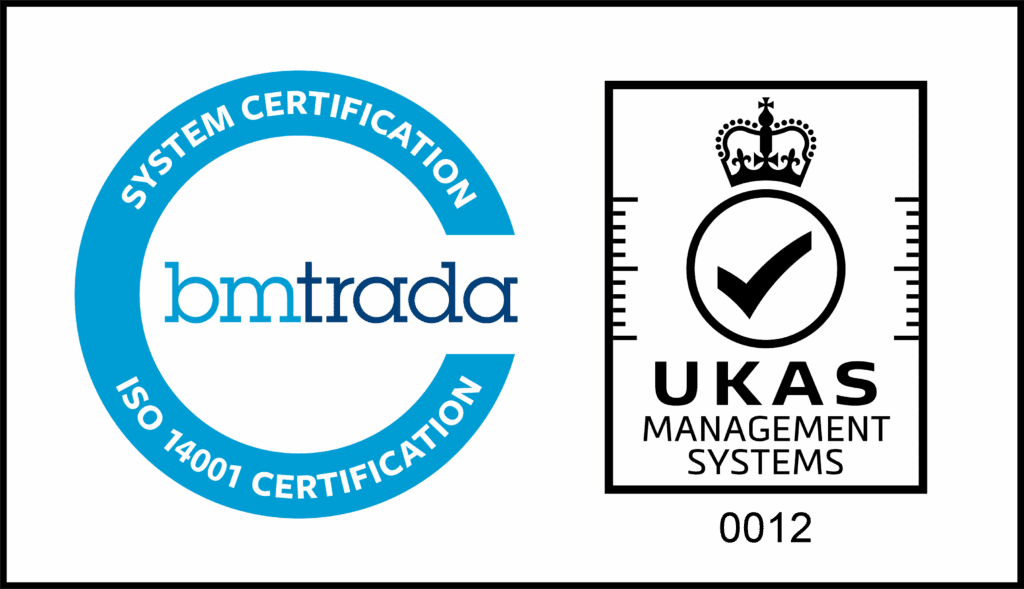In regulated manufacturing environments-particularly within sectors such as Medical Devices, Pharmaceuticals, Aerospace, and Personal Care-the ability to make reliable, data-driven decisions is only as strong as the measurement systems behind them. Whether verifying a critical dimension on a catheter hub, confirming surface uniformity on a molded syringe barrel, or monitoring precision components in aerospace assemblies, accurate and consistent measurement is a non-negotiable requirement for both product quality and regulatory compliance.
A Gage Repeatability and Reproducibility (Gage R&R) study is one of the most widely recognized tools for assessing the integrity of a measurement system. It quantifies how much of the observed variation in measurement results can be attributed to the measurement process itself-specifically, the equipment used (repeatability) and the operators or inspectors performing the measurements (reproducibility). The outcome of a Gage R&R study informs whether a measurement system is capable of delivering reliable, repeatable results or if it introduces unacceptable levels of variability that could compromise inspection accuracy.
In high-regulation industries, this distinction has serious implications. Global standards such as ISO 13485, FDA 21 CFR Part 820, and EU MDR require manufacturers to establish and maintain control over measurement processes that influence product quality. A poorly understood or unvalidated measurement system poses not only a risk to product conformity but also a liability in the event of an audit or investigation. From a compliance standpoint, demonstrating that your measurement systems are statistically validated is not just best practice-it is an expectation.
This article explores why Gage R&R studies are essential for compliance, detailing how they work, what regulators expect, and how manufacturers can embed them into their broader metrology and validation strategy. With increasing scrutiny on measurement traceability, data integrity, and quality system robustness, understanding the role of Gage R&R is critical for anyone responsible for metrology in a regulated environment.
Understanding Gage R&R and Its Components
To understand the value of a Gage R&R study, it’s essential to first grasp what constitutes a measurement system and how variation within that system affects inspection accuracy.
A measurement system, in the context of manufacturing and quality control, includes all elements involved in obtaining a measurement result. This comprises not only the measurement instrument (e.g., a digital caliper, CMM, or vision system) but also the operators, measurement procedure, environmental conditions, and the reference artifacts or parts being measured.
Core Components of a Measurement System
- Gage (or Measuring Device)
The physical tool or equipment used to capture dimensional or geometric data. This could range from manual hand tools to fully automated metrology systems.
- Operators (Appraisers)
Individuals who use the gage to perform measurements. Differences in technique, skill, or interpretation can introduce variability.
- Parts or Samples
The physical components being measured. Variation between parts is expected and should be distinguished from variation introduced by the measurement system.
- Measurement Process Environment
External factors such as temperature, humidity, vibration, and cleanliness, which can influence the performance of the gage and consistency of results.
What Gage R&R Measures
A Gage R&R study is a subset of Measurement System Analysis (MSA) that quantifies how much of the observed variation in measurement results is due to the measurement system itself rather than the parts being measured. Specifically, it isolates two sources of variability:
- Repeatability: Variation when the same operator measures the same part using the same gage multiple times under the same conditions.
- Reproducibility: Variation between different operators measuring the same part with the same gage under the same conditions.
The combined result-often expressed as a percentage of the total observed variation-indicates how much of the variation is due to the measurement system. A high Gage R&R percentage suggests that the measurement system introduces too much variation, making it difficult to distinguish part-to-part differences with confidence.
Types of Gage R&R Studies
There are several approaches to conducting a Gage R&R, depending on the study design and data requirements:
- Crossed Gage R&R: Used when each operator measures each part multiple times. Ideal when all parts can be measured by all operators.
- Nested Gage R&R: Used when each operator measures a unique set of parts. Useful when parts cannot be reused or when destructive testing is involved.
- ANOVA Gage R&R: A more statistically robust version that uses Analysis of Variance (ANOVA) to separate sources of variation and detect interactions between operator and part.
Each method has its place depending on the measurement process and constraints within the production environment. Regardless of method, the goal remains consistent: to understand how reliable the measurement system is for making critical quality decisions.
By quantifying measurement uncertainty through Gage R&R, manufacturers gain an objective basis for either accepting the measurement process or taking corrective actions-such as retraining operators, recalibrating equipment, or refining inspection procedures-to improve system performance.
Regulatory Landscape: Why Compliance Requires Measurement System Validation
In regulated industries such as MedTech, Pharmaceuticals, and Aerospace, manufacturers are obligated not only to produce conforming products but also to prove that they do so using validated processes and reliable inspection systems. Measurement system validation-including the application of Gage R&R studies-is a core requirement embedded in global quality and regulatory frameworks. Without it, even the most sophisticated manufacturing operations risk failing audits, facing product recalls, or breaching compliance.
Key Regulatory and Standards-Based Expectations
FDA 21 CFR Part 820.72 – Inspection, Measuring, and Test Equipment
The U.S. Food and Drug Administration (FDA) mandates that all manufacturers of medical devices must ensure their inspection and test equipment is capable of producing valid results. Specifically:
“Each manufacturer shall ensure that all inspection, measuring, and test equipment… is suitable for its intended purposes and is capable of producing valid results.”
It also requires manufacturers to establish procedures for calibration, maintenance, and control of measurement devices. A Gage R&R study, by quantifying the variability introduced by both equipment and operators, serves as objective evidence that the measurement system is suitable and valid.
ISO 13485:2016 – Clause 7.6: Control of Monitoring and Measuring Equipment
ISO 13485, the internationally recognized standard for medical device quality management systems, sets similar requirements:
“The organization shall determine the monitoring and measurement to be undertaken and the monitoring and measuring equipment needed to provide evidence of conformity… and ensure that it is calibrated or verified at specified intervals.”
Furthermore, the standard emphasizes that measurement uncertainty must be considered when it affects product conformity. A Gage R&R study directly supports this by highlighting how much measurement variability is intrinsic to the process.
EU MDR and ISO/IEC 17025
- The European Medical Device Regulation (EU MDR) includes expectations for documented evidence of conformity to specifications, which implicitly demands reliable and validated measurement systems.
- ISO/IEC 17025, the standard for calibration and testing laboratories, requires that the uncertainty of measurement and data integrity be understood and controlled.
Measurement Variability as a Compliance Risk
While product design and process control are obvious focus areas for auditors, measurement system capability is increasingly scrutinized during inspections. The inability to demonstrate confidence in measurement data can raise concerns in several areas:
- Data integrity: If measurement data is inconsistent or unverifiable, it can undermine the validity of batch release or final inspection records.
- Root cause investigations: Without a validated measurement system, nonconforming product investigations may fail to isolate actual defects from measurement noise.
- Risk management: In the context of ISO 14971 (risk management for medical devices), unvalidated measurement systems can be seen as an unmitigated risk to patient safety or product performance.
The Compliance Function of Gage R&R
By systematically verifying that a measurement system provides repeatable and reproducible results, Gage R&R studies satisfy both the letter and spirit of these regulatory requirements. They demonstrate that decisions based on measurement data-such as pass/fail judgments, statistical process control actions, or product release-are being made using trustworthy evidence.
Moreover, Gage R&R results form part of the documented quality record, which can be presented during regulatory audits, customer assessments, or internal quality reviews. When auditors ask, “How do you know your inspection data is reliable?” a recent and statistically valid Gage R&R study is a strong, defensible answer.
The Risk of Noncompliance Without Gage R&R
In highly regulated industries, the consequences of relying on unvalidated measurement systems go far beyond internal inefficiencies-they can escalate into regulatory violations, product recalls, and patient or end-user safety risks. When manufacturers forego Gage R&R studies, or fail to act on poor Gage R&R results, they expose themselves to a host of operational and compliance failures.
Measurement Error: The Hidden Threat to Product Quality
At first glance, measurement systems may appear to function adequately. Parts are being measured, results are recorded, and quality checks are passed. However, without quantifying the contribution of measurement error, organizations operate under a false sense of control. A non-capable measurement system can introduce undetected variability, where:
- Good parts are rejected (Type I error), causing unnecessary rework, scrap, or delayed shipments.
- Bad parts are accepted (Type II error), resulting in downstream failures, returns, or safety risks.
These risks are magnified when dimensional tolerances are tight-as is common in MedTech and Pharma manufacturing-where even small variations in inspection accuracy can result in nonconforming product entering the market.
Regulatory Findings and Audit Failures
Failure to validate measurement systems is a recurring issue in regulatory audits. Warning letters and audit observations from bodies such as the FDA, Notified Bodies, and MHRA regularly cite:
- Lack of evidence that measurement systems are capable of producing valid results.
- No documented Gage R&R or MSA for critical inspection equipment.
- Acceptance of test results from high-variation systems without justification.
These findings not only delay market access and damage supplier reputation but also trigger costly Corrective and Preventive Actions (CAPAs) and increased regulatory scrutiny.
Real-World Example (De-identified)
A European manufacturer of drug delivery devices received a major finding during an ISO 13485 audit due to the absence of Gage R&R data for a vision inspection system used in final release. While the system was calibrated, no studies had been conducted to assess how operator setup or lighting changes affected measurement variation. The auditors concluded that the measurement process was not validated, forcing the manufacturer into a remediation project that delayed release timelines and increased internal inspection requirements.
Financial and Operational Impact
Beyond compliance risks, failing to validate measurement systems through Gage R&R can have significant cost implications, including:
- Increased inspection and rework costs due to over-reliance on subjective measurements or high-variation gages.
- Delayed root cause analysis because measurement data cannot be trusted for decision-making.
- Wasted engineering and R&D time investigating false defects caused by poor repeatability.
- Customer dissatisfaction or loss of contracts if supplier measurement capability is questioned during audits.
The Illusion of Calibration as a Substitute
It is a common but flawed assumption that calibration alone ensures measurement system validity. While calibration confirms that a gage meets reference standards at specific points, it does not evaluate real-world performance under production conditions with multiple operators and part geometries. Gage R&R studies fill this gap by testing the measurement system as it is actually used, providing a more holistic and practical assessment of its effectiveness.
In summary, the absence of Gage R&R studies introduces a blind spot in quality control and regulatory compliance. Without them, manufacturers are effectively making quality decisions with unverified tools-an unacceptable risk in sectors where precision and compliance are non-negotiable.
How Gage R&R Supports Quality System Effectiveness
Within a robust quality management system (QMS), the reliability of measurement data is foundational. Decisions made across inspection, process control, validation, and final release all depend on the accuracy and consistency of the measurement systems in place. By providing objective data about the repeatability and reproducibility of those systems, Gage R&R studies serve as a key enabler of QMS effectiveness-supporting both compliance and continuous improvement.
Gage R&R as Part of Measurement System Analysis (MSA)
Gage R&R studies fall under the broader discipline of Measurement System Analysis (MSA), which examines how well a measurement process captures the true characteristics of a part. While MSA may also consider linearity, bias, and stability, Gage R&R remains the primary method for assessing precision under real-world operating conditions.
Incorporating Gage R&R into an MSA strategy allows organizations to:
- Validate the suitability of gages for their intended use.
- Compare performance across different measurement methods (e.g., contact vs. non-contact systems).
- Identify high-variation processes that require intervention.
- Establish baseline capability metrics for measurement improvement over time.
Impact on Key Quality Activities
A well-executed Gage R&R study has a ripple effect across multiple facets of quality management:
1. Inspection Strategy Development
Gage R&R results inform decisions on which inspection tools are appropriate for specific features, especially those with tight tolerances or critical-to-quality (CTQ) attributes. For example, a vision system with poor reproducibility may be unsuitable for final release inspection without further optimization.
2. Instrument Selection and Qualification
Before investing in new metrology equipment, many manufacturers use Gage R&R data to benchmark and compare gages. This ensures that new systems will reduce-not introduce-variation, and provides objective justification for procurement decisions.
3. Operator Training and Standardization
If reproducibility is a weak point in the measurement system, it often reflects inconsistent operator technique. Gage R&R data can guide targeted training programs, updated work instructions, or increased automation to minimize human variation.
4. Process Validation and Control
In process validation (e.g., IQ/OQ/PQ), the ability to reliably measure part dimensions is fundamental. A poor Gage R&R result could mask process variation, undermine statistical analysis, or result in false signals during SPC monitoring. Validating the measurement system ensures that downstream process data is trustworthy.
5. Supplier Quality and Incoming Inspection
For outsourced parts or assemblies, verifying the capability of supplier measurement systems-often via third-party or joint Gage R&R studies-adds a critical layer of assurance. This reduces the risk of receiving nonconforming product and facilitates smoother supplier audits.
Supporting Risk Management and Continuous Improvement
Under standards like ISO 14971 (risk management for medical devices) and ICH Q9 (quality risk management), organizations are required to identify and control sources of variability that impact product quality. A non-capable measurement system is a latent risk factor-one that may only be uncovered through Gage R&R analysis.
Moreover, by integrating Gage R&R into routine quality reviews, manufacturers can:
- Track improvements in measurement system capability over time.
- Use historical R&R data to assess the impact of process or equipment changes.
- Drive continuous improvement as part of CAPA or Six Sigma programs.
Enabling Proactive Quality Culture
Ultimately, a quality system that actively uses Gage R&R data demonstrates a mature, evidence-based approach to quality control. Instead of reacting to failed inspections or audit findings, manufacturers can proactively identify and mitigate risk in their measurement systems-before they impact production or compliance.
Best Practices for Implementing Gage R&R in Regulated Environments
Implementing a Gage R&R study in a regulated manufacturing setting involves more than running statistical software or gathering data-it requires deliberate planning, alignment with regulatory expectations, and a methodical approach to ensure results are reliable, traceable, and actionable. For teams operating in MedTech, Pharmaceutical, or Aerospace environments, the stakes are high. A poorly designed or misinterpreted Gage R&R study can result in misleading conclusions, compromised inspection processes, and audit vulnerabilities.
This section outlines best practices for conducting Gage R&R studies effectively within a compliant quality system framework.
- Determine When to Conduct a Gage R&R
A Gage R&R should not be treated as a one-time exercise. It must be strategically scheduled to align with risk and regulatory requirements. Common trigger points include:
- New gage or measurement system introduction.
- Changes in operator teams (e.g., new personnel, shift reassignments).
- Post-maintenance or recalibration events.
- Process changes impacting the measured feature (e.g., tooling, material, or part geometry changes).
- Recurring quality issues where measurement variation is a suspected root cause.
- Periodic reassessment, as part of preventive maintenance or annual quality review cycles.
In regulated environments, timing should also align with validation protocols, such as Installation Qualification (IQ), Operational Qualification (OQ), and Performance Qualification (PQ).
- Use Representative and Sufficient Sample Sizes
To ensure statistically meaningful results, the study must include:
- A realistic number of parts: Typically 10 distinct parts that represent the full range of process variation (e.g., high, nominal, and low tolerances).
- Multiple operators: Often 2 or 3, representative of those performing the measurements in production.
- Multiple trials per operator per part: Generally 2 or 3 measurements per operator on each part.
This standard 10×3×3 design (10 parts × 3 operators × 3 trials) is widely used, but it should be tailored to reflect actual inspection conditions and regulatory requirements.
- Standardize the Measurement Procedure
Repeatability and reproducibility can be strongly influenced by variation in how the measurement is performed. To reduce this source of error:
- Ensure that all operators follow the same measurement instructions, including part orientation, measurement sequence, and any preconditioning steps (e.g., cleaning).
- Use fixed fixtures or alignment jigs where possible to minimize human variability, especially with flexible or small parts common in MedTech applications.
- Record any deviations, interruptions, or anomalies during the study for traceability and context during analysis.
- Apply Clear Acceptance Criteria
Regulated industries require objective thresholds for decision-making. While general Gage R&R guidelines suggest:
- <10% Total Gage R&R (%GRR) = Acceptable
- 10–30% = Marginal, may be acceptable depending on context
- >30% = Unacceptable for most applications
These thresholds must be interpreted based on product risk and feature criticality. For example:
- A 20% GRR may be tolerable for non-critical cosmetic features.
- A 10% GRR may be too high for dimensional features that impact device function or patient safety.
Regulatory inspectors will expect not only to see the GRR result but also the rationale for its acceptability, especially for critical-to-quality (CTQ) features.
- Use the Appropriate Study Type
Select a study type that aligns with part availability and production constraints:
- Crossed Gage R&R: Best for reusable parts and non-destructive testing. Most accurate.
- Nested Gage R&R: Suitable when each operator must measure unique parts (e.g., destructive testing, single-use components).
- ANOVA Gage R&R: Useful for identifying interaction effects (e.g., operator-part interactions) and gaining deeper insights, especially with automated or complex systems.
Ensure that the analysis method (e.g., average and range method vs. ANOVA) is suitable for the statistical software and the complexity of the system under review.
- Document the Study Thoroughly for Audit Readiness
For compliance purposes, every Gage R&R study should include:
- A clear description of the study objective and scope.
- Identification of gages, operators, parts, and environmental conditions.
- Raw measurement data with date/time stamps.
- Statistical outputs and charts (e.g., %GRR, X-bar and R charts, interaction plots).
- Interpretation of results and action plan if criteria are not met.
- Approval signatures and document control per QMS requirements.
Auditors will look for both the results and evidence that the organization understands and acts upon the findings.
- Act on the Results: Close the Loop
A Gage R&R study is only useful if its results are reviewed, interpreted, and used to drive improvements. Depending on the outcome:
- Investigate causes of poor repeatability (e.g., mechanical issues, gage instability).
- Retrain operators or revise work instructions to reduce reproducibility error.
- Consider gage upgrades or automation to enhance consistency.
- In high-variation cases, temporarily suspend reliance on the measurement system until capability is restored.
Link Gage R&R findings to CAPA actions or continuous improvement initiatives where appropriate.
By following these best practices, manufacturers not only improve the reliability of their inspection systems but also reinforce the integrity of their entire quality management system. In regulated settings, the precision of your measurement system is often a reflection of the precision of your compliance posture.
Integrating Gage R&R into Validation Protocols
In regulated manufacturing environments, particularly within MedTech, Pharmaceuticals, and Aerospace, validation is a formal, documented process required to demonstrate that systems and processes consistently produce results meeting predetermined specifications. Within this framework, the performance of measurement systems is a critical component-yet often under-addressed. Integrating Gage R&R studies into equipment and process validation protocols ensures that inspection methods themselves are validated alongside the manufacturing process.
The Role of Gage R&R in IQ/OQ/PQ
Validation protocols are typically structured around the IQ/OQ/PQ model:
- Installation Qualification (IQ): Confirms that equipment is installed correctly and according to manufacturer specifications.
- Operational Qualification (OQ): Verifies that the system performs as intended under specified operating conditions.
- Performance Qualification (PQ): Demonstrates consistent performance in actual production settings over time.
Gage R&R is most closely aligned with OQ and PQ, where system performance under operational conditions is assessed. However, its relevance spans all three phases:
During IQ:
- Ensure that measurement equipment is installed, configured, and calibrated according to supplier specifications.
- Include documentation of gage capabilities and intended use to support future Gage R&R studies.
During OQ:
- Conduct a baseline Gage R&R to establish the measurement system’s performance in controlled, representative conditions.
- Assess whether variability from equipment and operators is within acceptable thresholds before process capability is evaluated.
During PQ:
- Reassess Gage R&R under real production conditions, including normal variation in environment, parts, and personnel.
- Use the results to confirm that the measurement system remains stable and suitable for routine inspection.
Inclusion of Gage R&R in validation ensures that process capability and product conformance data are trustworthy, forming a defensible part of the validation package.
Aligning Gage R&R with Regulatory Documentation
Both FDA and ISO-based frameworks emphasize the need for documented evidence of measurement system control and suitability. Integrating Gage R&R into validation protocols provides:
- Traceability: Demonstrates that dimensional inspection data used during validation is derived from qualified measurement systems.
- Justification: Supports the selection of specific inspection methods for critical-to-quality (CTQ) features.
- Repeatability assurance: Confirms that variability in inspection results is not masking or mimicking process variation.
As part of the validation file, Gage R&R data should be retained, reviewed, and referenced in key documents such as:
- Process Validation Protocols and Reports
- Measurement System Review Logs
- Risk Management Files (for ISO 14971 alignment)
Linking Gage R&R to Validation of Automated and Hybrid Systems
Increasingly, manufacturers are validating automated inspection systems, such as machine vision platforms, robotic metrology cells, or hybrid setups integrating CMMs with custom fixtures. In these scenarios, traditional validation documentation is insufficient without also addressing measurement variability. Gage R&R studies:
- Quantify the system’s consistency across lighting, positioning, and part orientation changes.
- Highlight whether operator input (e.g., part loading) introduces variation in semi-automated systems.
- Validate system performance across the expected operating range of parts and materials.
This is especially critical in MedTech or Pharma applications where automated inspection is used in final release testing, and regulators expect equivalent-or better-levels of control compared to manual inspection.
Cross-Functional Collaboration Is Key
Successfully integrating Gage R&R into validation requires coordination between multiple stakeholders:
- Quality Engineers: Define acceptance criteria and ensure results are documented for audit readiness.
- Validation Teams: Embed Gage R&R tasks and data requirements into IQ/OQ/PQ protocols.
- Metrology Teams: Design and execute the study, interpret results, and recommend improvements.
- Manufacturing/Operations: Provide access to typical parts, operators, and production conditions for realistic testing.
Early collaboration ensures that measurement system capability does not become a bottleneck during final validation phases or a source of noncompliance in post-market audits.
By embedding Gage R&R studies into validation processes, manufacturers can demonstrate that not only are their production systems under control-but the measurement systems evaluating those outputs are too. In a regulatory landscape that increasingly demands traceable, data-driven proof of control, this level of integration is essential for risk mitigation, audit readiness, and long-term process confidence.
Gage R&R in the Context of Advanced and Automated Metrology
As manufacturers in regulated industries increasingly adopt automated, multi-sensor, and vision-based metrology systems, the complexity of ensuring measurement system capability rises accordingly. While these technologies offer significant advantages-such as improved throughput, reduced operator subjectivity, and the ability to capture high-resolution data-they also introduce new challenges for traditional Gage R&R methodologies. For Quality and Metrology teams, adapting Gage R&R studies to suit these advanced systems is essential to maintain compliance and data integrity.
Unique Challenges with Automated Systems
1. Complexity of Measurement Algorithms
Automated systems often rely on software algorithms to detect features, edges, or geometries. These algorithms can introduce variation due to:
- Differences in lighting or contrast
- Image processing thresholds
- Software version changes
- Feature recognition limitations on difficult geometries
In such cases, measurement variation may not stem from hardware instability or operator error-but from algorithmic sensitivity. A traditional Gage R&R study may need to be augmented with image variation or algorithm validation testing to fully assess repeatability and reproducibility.
2. Reduced Human Involvement-But Not Zero
While automation reduces human input, operators may still influence measurement results through:
- Part loading or fixturing inconsistencies
- Selection of measurement programs
- Parameter inputs (e.g., part orientation, batch settings)
These human-influenced variables must be included in the reproducibility component of the Gage R&R study. In semi-automated systems, operator-to-operator variation can still be significant.
3. Machine Stability vs. Measurement Environment
Automated metrology systems may appear inherently stable-but their performance is still subject to environmental influences, such as:
- Temperature fluctuations (especially for CMMs)
- Vibration or airflow near sensitive sensors
- Material reflectivity or translucency (impacting vision systems)
A properly designed Gage R&R should account for these variables by conducting trials under representative environmental conditions, including typical lighting and part surface variations.
Adapting Gage R&R Methodology for Advanced Systems
To ensure Gage R&R studies remain meaningful for advanced metrology systems, consider the following adaptations:
A. Use of ANOVA Gage R&R
The ANOVA (Analysis of Variance) method is preferred over the Average & Range method for complex systems because it can:
- Detect interaction effects between parts and operators
- Isolate variance components with greater precision
- Provide confidence intervals for %GRR values
This is especially useful when studying semi-automated systems or hybrid setups where interaction effects may obscure underlying trends.
B. Include Systematic and Random Error Analysis
In systems where software algorithms perform edge detection or feature extraction, conduct repeatability testing at the pixel or sub-pixel level. Some manufacturers supplement Gage R&R with:
- Software version validation: Confirming measurement consistency after software updates.
- Lighting condition tests: Testing measurement consistency under varied but acceptable lighting settings.
- Fixture validation: Verifying that mechanical or vacuum fixtures maintain part position to required tolerances.
C. Test Across the Full Operational Envelope
Rather than using only nominal parts, test across the entire tolerance range for critical features. This helps identify whether the automated system’s repeatability holds at tolerance extremes-an important consideration for regulatory audits.
Fixture-Based and Multi-Sensor Metrology: A Special Consideration
For systems involving custom fixtures, multi-part inspection, or multi-sensor measurement platforms, Gage R&R must be adapted to assess system-level variation:
- Fixture repeatability: Confirm that the fixture holds the part in a consistent orientation across operators and cycles.
- Sensor-to-sensor consistency: Evaluate whether tactile and optical sensors deliver statistically comparable results on the same feature set.
- Program-to-program variation: If multiple inspection programs exist for different part variants, validate their output consistency.
These studies are particularly relevant when custom metrology solutions-such as those developed for high-speed inspection in MedTech-are used for high-throughput production.
Regulatory Perspective: Automation Does Not Eliminate Responsibility
Regulators increasingly view automation as a capability enhancer, but not a compliance substitute. Automated systems must still demonstrate that:
- Measurement variability is controlled and quantified.
- Measurement output is traceable, verified, and validated.
- Operators are adequately trained to interact with the system correctly.
Gage R&R studies are a primary method of showing that automation enhances-not undermines-measurement reliability. In FDA and ISO 13485 inspections, auditors may specifically ask how automated systems were validated for repeatability and what evidence supports their use in final product release.
While advanced and automated metrology systems offer undeniable benefits in regulated manufacturing environments, they do not exempt organizations from validating measurement capability. On the contrary, their complexity demands a more rigorous, tailored approach to Gage R&R. Properly adapted, these studies remain a powerful tool to demonstrate that even in automated settings, inspection systems are capable, compliant, and ready for regulatory scrutiny.
Conclusion
In regulated manufacturing environments, particularly across MedTech, Pharmaceutical, Personal Care, and Aerospace industries, the reliability of measurement data is foundational to both product quality and regulatory compliance. No matter how advanced the manufacturing or inspection technologies, a critical question remains: Can you trust your measurement results?
Gage Repeatability and Reproducibility (Gage R&R) studies provide the data-driven answer to that question. By quantifying the variability introduced by measurement equipment and operators, Gage R&R validates that your inspection system is fit for purpose-able to consistently differentiate good parts from bad with a high degree of confidence.
Throughout this article, we’ve established the central role that Gage R&R plays in maintaining compliant, effective quality systems:
- It aligns directly with regulatory requirements under FDA 21 CFR Part 820, ISO 13485, and EU MDR, which demand that inspection systems are validated and capable of producing valid results.
- It protects manufacturers from the operational and compliance risks of making decisions based on unreliable measurements, including false rejects, missed defects, and audit findings.
- It informs smarter decisions in inspection strategy design, operator training, equipment procurement, and process validation-ensuring measurement systems support, rather than undermine, product conformance.
- It remains critical even in automated and advanced metrology environments, where algorithmic or environmental variation can still impact repeatability and reproducibility.
Ultimately, integrating Gage R&R into your quality and validation protocols is more than a statistical requirement-it’s a strategic necessity for building trust in your data, your processes, and your products.
Next Steps:
If you’re evaluating the capability of your current measurement systems-or planning to validate new equipment for critical applications-visit our Gage R&R service page to learn how Verus Metrology can support statistically sound, audit-ready studies tailored to your needs.
For more insights on Measurement System Analysis, metrology validation, or implementing automated inspection strategies in high-compliance environments, contact our metrology experts directly.
